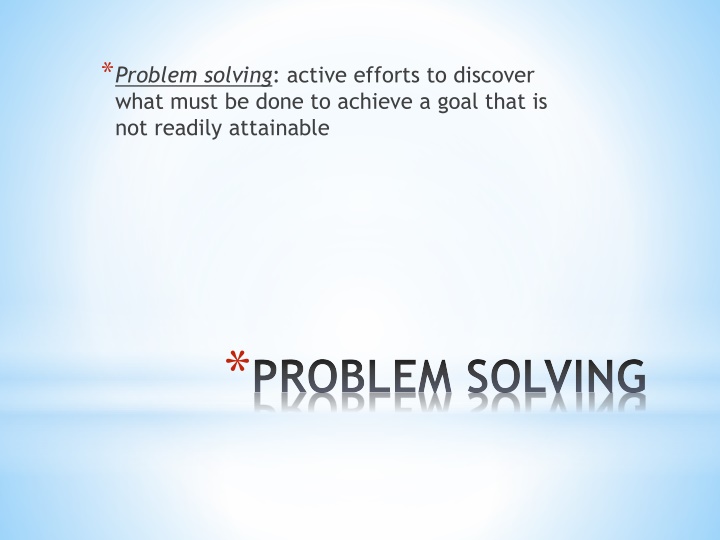
Problem Solving and Barriers to Effective Solutions
Explore the principles of problem solving, different types of problems, barriers that hinder effective solutions, and various approaches to enhance problem-solving skills. Learn how well-defined and ill-defined problems, irrelevant information, mental sets, and unnecessary constraints affect problem-solving processes. Discover heuristic methods, algorithms, problem spaces, and strategies like forming subgoals, working backward, searching for analogies, and changing problem representations.
Download Presentation

Please find below an Image/Link to download the presentation.
The content on the website is provided AS IS for your information and personal use only. It may not be sold, licensed, or shared on other websites without obtaining consent from the author. If you encounter any issues during the download, it is possible that the publisher has removed the file from their server.
You are allowed to download the files provided on this website for personal or commercial use, subject to the condition that they are used lawfully. All files are the property of their respective owners.
The content on the website is provided AS IS for your information and personal use only. It may not be sold, licensed, or shared on other websites without obtaining consent from the author.
E N D
Presentation Transcript
*Problem solving: active efforts to discover what must be done to achieve a goal that is not readily attainable *PROBLEM SOLVING
*Problems of inducing structure: relations among numbers, words, symbols, ideas *Problems of arrangement: arranging parts of a problem to fit some criterion---solved through insight: sudden discovery of the correct solution following incorrect attempts based on trial and error *TYPES OF PROBLEMS
*Problems of transformation: carry out a sequence of transformations in order to reach a specific goal *TYPE OF PROBLEMS
*Well-defined problems: problems in which the initial state, the goal state, and the constraints are clearly specified *Ill-defined problems: one or more elements among the initial state and the constraints are unclearly specified *WELL-DEFINED VS. ILL-DEFINED PROBLEMS
*Irrelevant info *Functional fixedness: the tendency to perceive an item only in terms of its most common use *Mental set: when people persist in using problem solving strategies that have worked in the past *Unnecessary constraints *BARRIERS TO EFFECTIVE PROBLEM SOLVING
*Problem Space: the set of possible pathways to a solution considered by the problem *Algorithm: methodical, step-by-step procedure for trying all alternatives *Like trial and error *Heuristic: a guiding principle used in solving problems or making decisions *A rule of thumb *APPROACHES TO PROBLEM SOLVING
*Forming subgoals: intermediate steps *Working backward: easy w/problem w/well specified end-point *Searching for analogies *Changing the representation of the problem: change the way you look at a problem *TYPES OF HEURISTICS
*Field dependence-independence: tendency to rely primarily on external versus internal frames of reference when orienting yourself in space *Field dependent rely on external frames of reference *Field independent can restructure problem more easily *CULTURE, COGNITIVE STYLE, AND PROBLEM SOLVING
*DECISION MAKING: CHOICES AND CHANCES
*DEF: evaluating alternatives and making choices among them *Theory of bounded rationality: asserts that people tend to use simple strategies in decision making that focuses on only a few facets of available options and often result in irrational decisions that are less than optimal *DECISION MAKING
*Decisions involve choices about preferences *Additive strategy: list attributes that influence a decision *Compensatory decision models: allow attractive attributes to compensate for unattractive attributes *Or could use a: elimination by aspects strategy *Noncompensatory decision models: do not allow some attributes to compensate for others *Used when more options and factors are added to a decision task *MAKING CHOICES: SELECTING AN ALTERNATIVE
*Risky decision making: making choices under conditions of uncertainty *Expected value: do you expect to gain or lose *Subjective utility: is it personally worth it to you *Subjective probability: sometimes you need to rely on your personal estimates of probabilities *TAKING CHANCES: FACTORS WEIGHED IN RISKY DECISIONS
*Availability heuristic: involves basing the estimated probability of an event on the ease of with which relevant instances come to mind *Recalling specific instances of an event *HEURISTICS IN JUDGING PROBABILITIES
*Representativeness heuristic: basing the estimated probability of an event on how similar it is to the typical prototype of that event *HEURISTICS IN JUDGING PROBLEMS
*People underestimate risks or probabilities * It won t happen to me *TENDENCY TO IGNORE BASE RATES
*DEF: when people estimate that the odds of two uncertain events happening together are greater than the odds of either event happening alone *CONJUNCTION OF FALLACY
*DEF: when peoples belief about whether an outcome will occur changes depending on how alternative outcomes are distributed, even though the summed probability of the alternative outcomes is held constant *ALTERNATIVE OUTCOMES EFFECT
